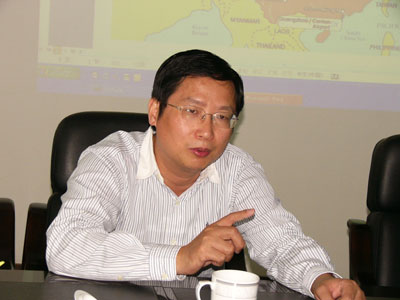This report is on the second part of NextInsight’s visit to two petrochemical related plays located in Jiangsu. The first report was on Sunpower titled SUNPOWER: My visit to an intelligent city that spawns intelligent businesses.

"MAINTAINING A CHEMICAL storage hub is like guarding a warehouse for explosives,” said Hengyang’s founder and CEO, Mr Gu Wenlong.
For this reason, safety is always the first thing on Mr Gu’s mind.
In fact, the ponderous technical details required to run the business is a deterrent to any competitor eyeing Hengyang’s fat margins, which were in excess of 30% in FY08.
A second deterrent: the high cost of building storage tanks, and the many levels of licenses and approvals needed from local, provincial, and national government.
For example, Hengyang’s plans to increase capacity by more than twofold will cost a whopping Rmb 240 million, several times its 1H09 revenues of Rmb 31.7 million.
And technicians for a chemical storage hub need to be employed as early as during the construction phase.
These administrative expenses during expansion, which kick in before lease income can be collected from operating the tanks, are why Hengyang's FY08 gross profits fell year-on-year.

Even the petrochemical giants prefer to engage professional storage service providers to avoid substantial investment in facilities and operations.
"Most petrochemical operations are state-owned in China, so I was pleasantly surprised to find Hengyang," said Mr Rocky Lu, who visited Hengyang's facilities with a group of investors, analysts and NextInsight last week.
Mr Lu's fund, known as China Best, is based in Shanghai and has several million dollars invested in S-chips.
At historical price earnings of 6.7 times, some investors may consider Hengyang more pricey than some other S-chips, but Mr Lu believes that cash flow is more important than price earnings ratios.
Its net cash flow from operations was Rmb 18.4 million in 1H09.
Hengyang's storage facility sits near the mouth of the Yangtze River, which is also known as China’s golden waterway.

The economic belt along this golden waterway happens to be the nation’s economic powerhouse, contributing close to 50% of GDP, and about 35% of exports.
The Yangtze River spans a mighty 6,300 kilometers, passing through 7 provinces and 2 sub-provincial cities, connecting east, mid and west China via water transport, and geographically demarcating the north and the south.
Our recent report on Hengyang highlighted its high net margins (in excess of 30%), its diversified exposure to the chemical industry, and its defensive revenue stream.
Upon visiting Hengyang’s chemical storage facility last week, I found something even more interesting – its expansion plan upstream along the golden waterway.
Yangtze River’s sole chemical logistics chain
Upon completion of its aggressive expansion plans, Hengyang envisions itself being the sole chemical logistics chain operating a one-stop solutions for port, land transport and storage hubs along the Yangtze River.
”The Transport Authority’s permit to operate a petrochemical jetty along the coastline is very important to chemical logistics operators and difficult to obtain,” said Mr Gu, the CEO.
The company does not currently operate any jetty and leases third-party facilities.
But it is building its own jetty that will pipe chemicals to its storage hub at Jingjiang, Deqiao.

Last week, I was with a group of about 10 analysts and investors checking out phase one of its new storage hub under construction at Deqiao, which is expected to be completed by the first quarter of next year.
Including phase 2, the capacity will increase more than fourfold to 439,600 cubic meters, comprising of 49 tanks at Jiangyin and 118 tanks at Deqiao across the river.
Hengyang currently has 37 tanks at Jiangyin with a total capacity of 97,600 cubic meters.
Thereafter, it intends to build chemical storage hubs with jetties along the Yangtze River at Jiujiang, Yueyang and Wuhan, serving the respective petrochemical and industrial parks there.
”We will be the first chemical logistics chain with an integrated one-stop solutions service incorporating port, jetty system, tankers and inland storage tanks along a major stretch of the Yangtze River,” said Mr Gu.
Read what we wrote during Hengyang's IPO: Lucrative chemical logistics player is today's IPO




